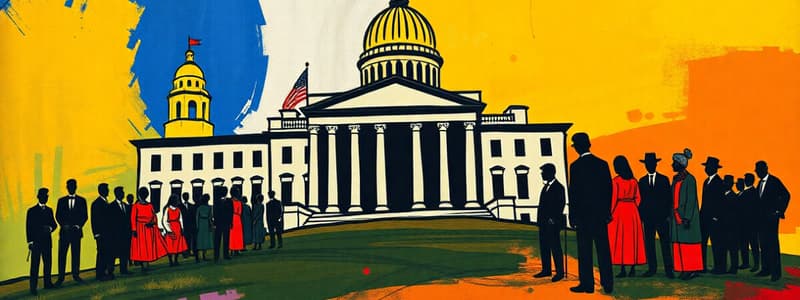Podcast
Questions and Answers
What is federalism described as?
What is federalism described as?
- A system where local governments have supreme power.
- A middle ground between state dominance and a powerful central government. (correct)
- A system with an all-powerful central government.
- A system where states dominate.
What protection does the Constitution provide to states regarding their boundaries?
What protection does the Constitution provide to states regarding their boundaries?
- No state can be divided or merged with another without the states' approval. (correct)
- The federal government can alter state boundaries at will.
- States can be divided or merged without their consent.
- Only the Supreme Court can decide on state boundary changes.
What military force can states maintain?
What military force can states maintain?
- A military force called the National Guard under the governor's control. (correct)
- Foreign legions with approval from Congress.
- A standing army under state control.
- A navy independent of the federal government.
Which action is prohibited to the states by the Constitution?
Which action is prohibited to the states by the Constitution?
What form of aid does the federal government provide to states to help fund programs?
What form of aid does the federal government provide to states to help fund programs?
What does the federal government guarantee each state against, according to Article IV?
What does the federal government guarantee each state against, according to Article IV?
What is the process called when a governor returns a suspected criminal to the state where the crime was committed?
What is the process called when a governor returns a suspected criminal to the state where the crime was committed?
What must states do in order to receive grants-in-aid from the federal government?
What must states do in order to receive grants-in-aid from the federal government?
Besides funding, what service do states provide to the federal government?
Besides funding, what service do states provide to the federal government?
Which amendment to the U.S. Constitution establishes reserved powers for state governments?
Which amendment to the U.S. Constitution establishes reserved powers for state governments?
Which of the following is an example of a reserved power?
Which of the following is an example of a reserved power?
What are powers shared by both state and federal governments called?
What are powers shared by both state and federal governments called?
What does the Supremacy Clause of the Constitution state?
What does the Supremacy Clause of the Constitution state?
According to the content, who decides conflicts between states and the federal government?
According to the content, who decides conflicts between states and the federal government?
Since the 1930s, what has been a trend in the relationship between state and federal governments?
Since the 1930s, what has been a trend in the relationship between state and federal governments?
Funds allotted by Congress are often intended to aid whom?
Funds allotted by Congress are often intended to aid whom?
Flashcards
Federal System
Federal System
A system dividing power between a national government and state governments.
Federalism
Federalism
A balance where neither central government nor states are all-powerful.
State Boundary Protection
State Boundary Protection
States must approve if another state wants to merge or divide.
National Guard
National Guard
Signup and view all the flashcards
Powers Prohibited to States
Powers Prohibited to States
Signup and view all the flashcards
Grants-in-aid
Grants-in-aid
Signup and view all the flashcards
Full faith and credit
Full faith and credit
Signup and view all the flashcards
Protection of states
Protection of states
Signup and view all the flashcards
Republican government
Republican government
Signup and view all the flashcards
Extradition
Extradition
Signup and view all the flashcards
Interstate cooperation
Interstate cooperation
Signup and view all the flashcards
Port Authority example
Port Authority example
Signup and view all the flashcards
Reserved Powers
Reserved Powers
Signup and view all the flashcards
Examples of Reserved Powers
Examples of Reserved Powers
Signup and view all the flashcards
Concurrent Powers
Concurrent Powers
Signup and view all the flashcards
Supremacy Clause
Supremacy Clause
Signup and view all the flashcards
Supreme Court's Role
Supreme Court's Role
Signup and view all the flashcards
Governmental Cooperation
Governmental Cooperation
Signup and view all the flashcards
Purpose of Federal Funds
Purpose of Federal Funds
Signup and view all the flashcards
Examples of Funded Areas
Examples of Funded Areas
Signup and view all the flashcards
Study Notes
- The Constitution establishes a federal system where the national government has certain powers, and others are reserved for the states.
- Powers not delegated to the federal government, nor prohibited to the states, are reserved to the states or to the people.
Federalism
- Federalism is a middle ground between a powerful central government and a system dominated by states.
- The writers of the Constitution aimed to limit national power without making states so strong that the federal government becomes ineffective.
Protecting States
- The Constitution protects states in several ways.
- States cannot be divided or merged without their consent or approval.
- States can maintain a militia, known as the National Guard, under the control of the state's governor.
- In a national emergency, the President can federalize the National Guard, placing it under the control of the U.S. armed forces.
Powers Prohibited to the States
- States are generally free to govern themselves, but the Constitution sets limits.
- States cannot declare war, issue their own money, or impose taxes on imports from other countries or states.
- The Fourteenth Amendment guarantees all Americans equal protection under the laws.
Reserved Powers
- The Tenth Amendment establishes that state governments can exercise powers not given to the federal government or denied to the states.
- Reserved powers include the power to make marriage laws, regulate education, and hold elections.
- States are responsible for the public health, safety, and welfare of their citizens.
- Reserved powers also include setting up police forces, building roads and bridges, setting educational requirements, and organizing local governments.
Concurrent Powers
- The Constitution grants concurrent powers, which are shared by both state and federal governments.
Supremacy Clause
- Article VI of the Constitution states that laws made by Congress are the "supreme law of the land."
- The Supreme Court resolves conflicts between states and the federal government.
- If a state law conflicts with a national law, the national law must be followed.
Governmental Cooperation
- Since the 1930s, state and federal governments have increasingly cooperated to fund and administer various programs.
- Congress allots money to aid state and community citizens, including funds for highways, education, and welfare.
Grants-in-Aid
- The federal government provides grants-in-aid (money awards) to states to help them pay for programs.
- States must contribute their own funds and obey rules set by Congress to receive these grants.
Cooperation Among States
- Article IV of the Constitution encourages interstate cooperation by requiring states to give "full faith and credit" to the public laws and court decisions of other states.
- A car registration or corporate charter issued by one state must be accepted in all states.
Form of Government
- The federal government protects each state against invasion and domestic violence.
- Article IV requires every state to have a "republican form of government."
- When a state or local police force cannot control violent incidents, the governor can request assistance from federal troops.
- States provide services to the federal government, such as conducting elections for state officials.
Extradition
- Article IV ensures another type of cooperation.
- A person who breaks the law in one state may flee to another to avoid punishment.
- A state cannot legally punish a person for breaking the laws of another state.
- Returning a suspected criminal to the state where the crime was committed is called extradition.
Sharing Responsibilities
- States cooperate, especially when sharing a border.
- The Port Authority manages bridges, airports, and transportation facilities serving both states (e.g., New York and New Jersey).
State Constitutions
- Each state has its own constitution.
- A state constitution, similar to the U.S. Constitution, serves as a plan of government.
- State constitutions share many characteristics, though they differ in detail from the U.S. Constitution.
Typical Form and Content
-
Every state constitution provides for separation of powers among the legislative, executive, and judicial branches.
-
State constitutions outline the organization of each branch, the powers and terms of various offices, and the method of election for state officials.
-
State constitutions have their own bills of rights, which include most or all Bill of Rights protections in the U.S. Constitution.
-
State constitutions may include rights not in the national Constitution.
-
Examples of this include workers' rights to join unions and protections for the physically challenged.
-
State constitutions establish different types of local governments, such as counties, townships, municipalities, special districts, parishes, and boroughs.
-
State constitutions regulate how state and local governments can raise and spend money.
-
State constitutions establish independent state agencies and boards.
-
A state's constitution is its highest law, but cannot clash with the U.S. Constitution.
Studying That Suits You
Use AI to generate personalized quizzes and flashcards to suit your learning preferences.




